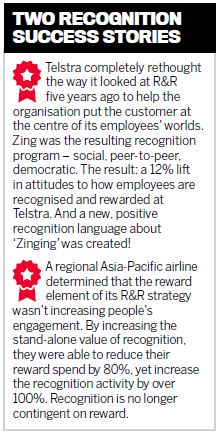
Sometimes the bells and whistles get in the way of why recognition is so important in the first place. HRD outlines why the fundamentals matter

Sometimes the bells and whistles get in the way of why recognition is so important in the first place. HRD outlines why the fundamentals matter
Few would disagree that the workplace has changed more in the last two or three years than it probably has in the preceding two decades – and these changes are making it harder than ever to successfully engage employees. Consider the following: demographics have changed; there are more part-time and casual workers; people don’t necessarily have a bricks-and-mortar place to show up to work; and there’s an increasing need (and demand) for flexible workplaces – to name just a few upheavals.
“The changes taking place are forcing HR professionals to think about the practices and the ways in which we connect with our employees and the way we facilitate their successes and their achievements on a dayto- day basis,” says Colin Ng, Sales Director, Singapore, Grass Roots Asia-Pacific.
Ng says new technology is adding another layer of complexity – but also a new wave of solutions – for employers who want to acknowledge the exceptional work of their employees.
In a complex world, it can pay dividends to return to basics. But just what is best practice reward and recognition in 2017?
Reward vs recognition
Firstly, a clarification is needed. While it appears that ‘reward’ is often tied directly to ‘recognition’, it seems some organisations typically favour one over the other – but it may not be the right one.
Jeremy Salter, Employee Engagement Lead at Grass Roots Asia-Pacific, suggests the amount an organisation invests in discretionary rewards is typically far greater than the amount invested in employee recognition. This is perhaps surprising as the evidence suggests that employee recognition is a more effective motivational tool than employee reward.
An underinvestment in recognition can reflect an overdependence on reward. In some organisations recognition and reward are joined at the hip. The value of recognition is contingent upon the size of the reward.
One way to reduce this costly dependence on reward is to increase the stand-alone value of recognition within an organisation.
Social technologies have helped. Social recognition programs amplify the value of employee recognition by increasing immediacy and visibility. Salter suggests the stand-alone value of employee recognition is further enhanced by integrating employee recognition with other talent management processes, including performance, recruiting and onboarding.
One other factor as to why ‘reward’ is less appealing is simply the cost to the business. Industry benchmarks suggest 1–2% of payroll should be allocated to non-cash reward (ie outside of payroll). However, challenges including FBT compliance for employees mean such rates could be excessive. The inverse of course is also true. Too little reward and employees will see that it is tokenistic and not worth the discretionary effort to strive for.
“Whilst reward is important and should be used in conjunction with a modern recognition program, it’s the organisations that take employee recognition seriously who are reducing their dependence upon reward,” says Ng.
Getting the foundations right
Ng suggests there are three critical aspects to consider for any organisation looking to clean the slate and reinvent its recognition program.

Adding to these foundational elements is the culture of an organisation. Does it foster recognition? Although recognition is actually one of the simplest things to do, Ng says we often find it hard, because we may feel embarrassed giving or receiving in-person praise; or we are separated by geography or even floors in an office; or the organisation has made it hard through complicated nomination programs that take weeks to get recognition to the actual employee.
“Most leaders understand the power of recognition. But many don’t realise the importance of giving frequent, timely and relevant recognition both in person and via programs like those run by Grass Roots,” Ng says.
To ensure leaders in businesses know what good recognition is, Grass Roots has launched Achievers University. Available to administrators within Grass Roots programs, the University has modules to help train people in what good recognition looks like and why it’s important to be recognising people every day. This enables HR leaders to work with their peers to implement the best practice R&R for their business.
Leaders also need real-time data. Comprehensive reporting suites are needed to inform leaders of how they and their teams are recognising and rewarding their colleagues.
Finally, the role of the C-suite should never be underestimated. Telstra’s program (see boxout) was so successful because former CEO David Thodey was one of the highest givers of recognition. This was visible to all employees through recognition news feeds, helping make recognition a new communication channel.
Recognition in the flow of work
To truly create a culture that fosters recognition, it’s necessary to build recognition into the ‘flow of work’ so employees don’t have to think about recognising someone, they are able to just do it.
The Achievers Employee Success platform, now in Asia-Pacific through Grass Roots, makes it easier for businesses to integrate more recognition activity in the one place. Using open APIs – widgets that can be deployed in just about any application – and modules such as Engagement Pulse, the Achievers hub ensures that employees don’t have to access multiple systems, removing a key barrier for businesses looking to develop their R&R strategy.
Native mobile apps then extend the usability of technology. “You can empower your employees now to witness a great act at the end of a day and have an employee recognise another for thinking ‘Customer First’. That person’s manager reads the recognition, promotes it via an Everyday Award – think a nominal fixed value such as $50 – and the recognised employee gets a double burst of recognition. And with the mobile app, employees can see the recognition immediately and can even spend the reward on a treat or the basics such as shopping on their way home.”
A helping hand
Truly meaningful reward and recognition strategies need to be broader and to encompass more elements than ever, as the nature of what people want to be recognised for, and the different types of reward that now exist, add complexity to a dramatically different HR environment. Technology – and trusted business partners – can ensure your workplace not only survives these tumultuous times, but thrives.
GRASS ROOTS
Grass Roots is one of the world’s leading providers of customer and employee engagement solutions. With our Achievers Employee Success platform we help businesses better engage their employees through social recognition, helping increase employee engagement and ultimately creating a happier, healthier and safer workplace. Visit www.achievers.com.sg to find out more, or click here to visit the Achievers blog